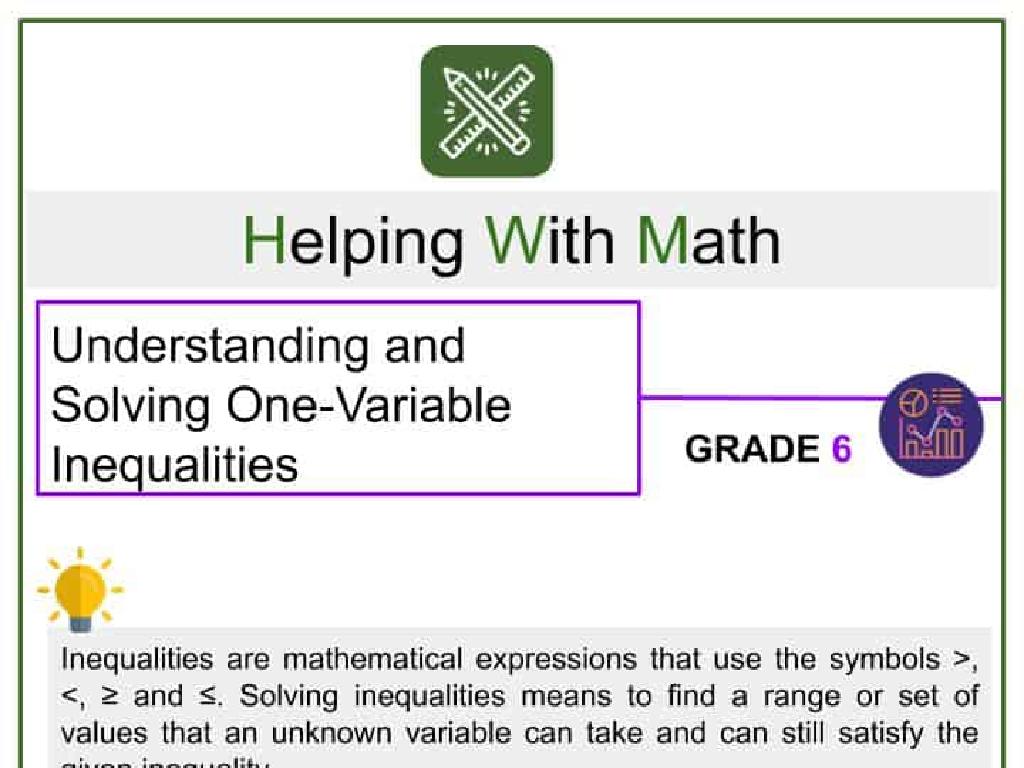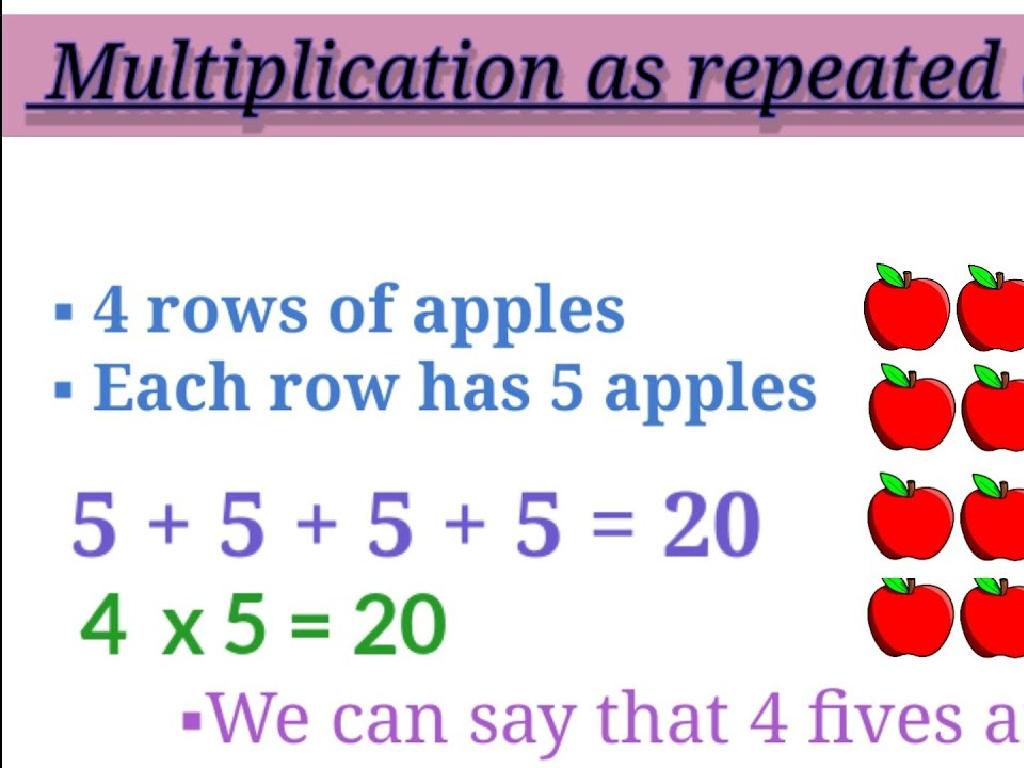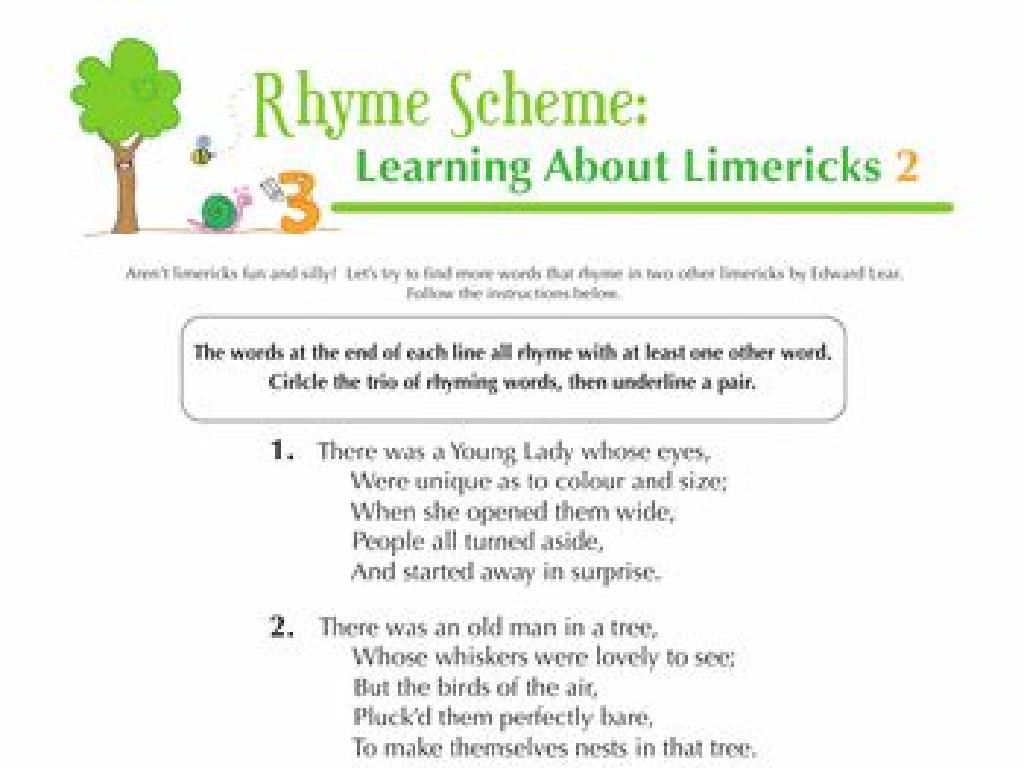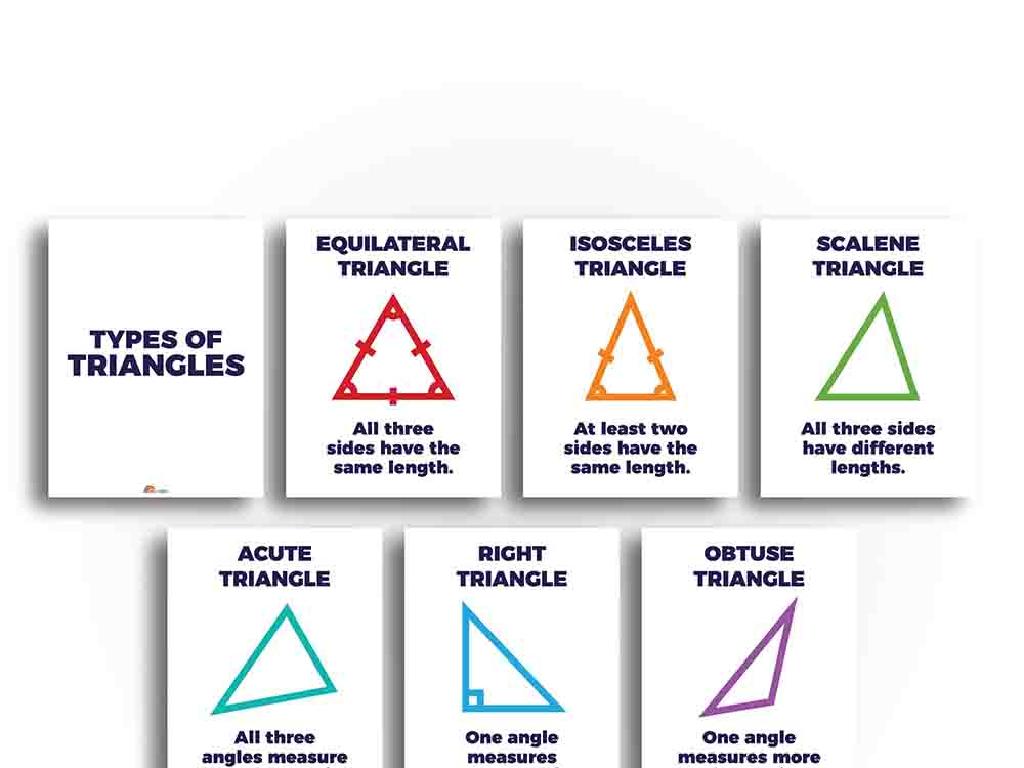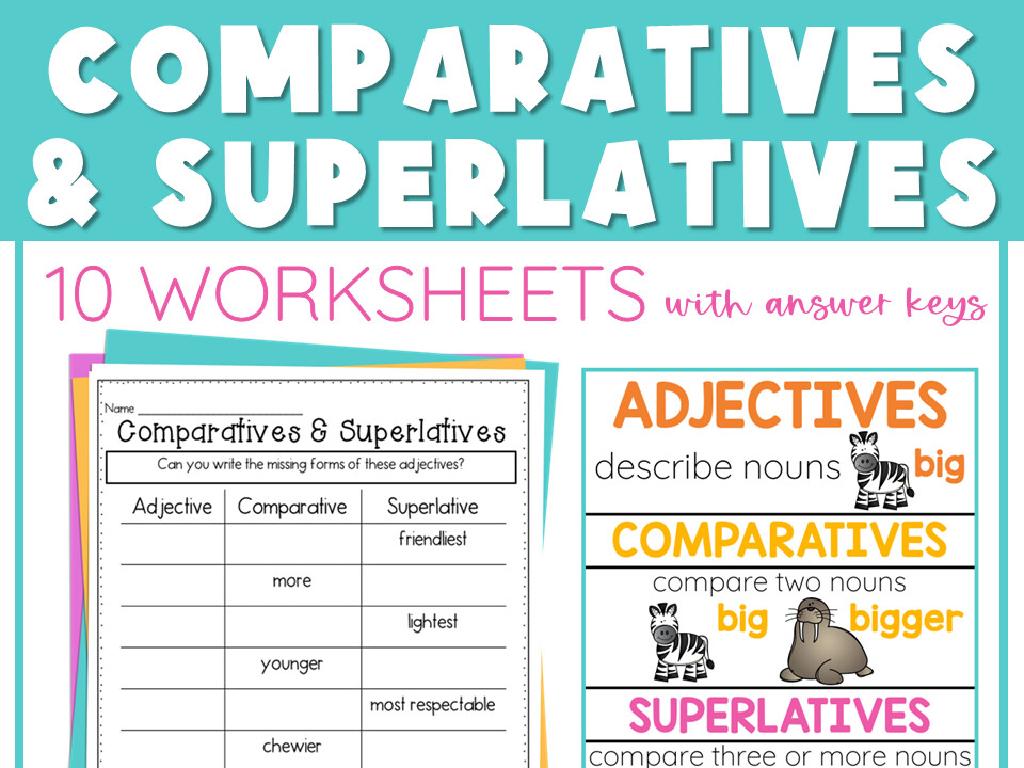Identify The Irregular Past Tense Ii
Subject: Language arts
Grade: Third grade
Topic: Verb Tense
Please LOG IN to download the presentation. Access is available to registered users only.
View More Content
Today’s Adventure: Irregular Past Tense II
– Verbs: Present to Past
– Verbs tell us about actions. They change form to show past actions.
– Recap: What’s a verb?
– A verb is an action word, like ‘run’ or ‘think’.
– Regular vs. Irregular Verbs
– Regular verbs add -ed for past tense. Irregular verbs don’t follow this rule.
– Practice with Irregular Verbs
– We’ll learn some irregular verbs through fun activities.
|
This slide introduces the concept of irregular past tense verbs to third graders. Begin by explaining how verbs indicate actions and how they change when talking about past events. Recap the definition of a verb and the regular past tense form, which typically ends in -ed. Contrast this with irregular verbs, which do not follow the standard -ed ending pattern. Engage the class with examples and interactive activities to help them understand and memorize irregular verbs. Encourage students to think of verbs from their daily life and consider how they might change in the past tense. The goal is to make them comfortable with identifying and using irregular past tense verbs in both spoken and written English.
What Makes a Verb Irregular?
– Irregular verbs break rules
– ‘Go’ turns into ‘went’
– Unlike ‘walk’ to ‘walked’, ‘go’ becomes ‘went’
– Some verbs never change
– Words like ‘cut’ stay the same even in the past
– Irregular verbs are unique
– Each irregular verb has its own past form
|
This slide introduces the concept of irregular verbs to third graders, emphasizing that they do not follow the standard ‘add -ed’ rule to form the past tense. Provide clear examples to illustrate the point, such as ‘go’ changing to ‘went’ instead of ‘goed’. Highlight that some verbs, like ‘cut’, ‘let’, and ‘put’, remain the same in both present and past tense. Explain that irregular verbs must be memorized because they do not follow a pattern. Encourage students to think of other verbs they know and guess if they are regular or irregular. This will help them understand that irregular verbs are unique and require special attention.
Discovering Patterns in Irregular Verbs
– Irregular verbs change vowels: ‘sing’ to ‘sang’
– Like ‘ring’ to ‘rang’ and ‘sit’ to ‘sat’
– Some verbs change entirely: ‘eat’ to ‘ate’
– ‘Go’ becomes ‘went’ and ‘is’ becomes ‘was’
– Become verb detectives
– Find patterns in irregular verbs
– Look for verbs that don t follow the ‘ed’ rule
|
This slide is aimed at helping third graders recognize patterns in irregular verbs, which do not follow the standard ‘-ed’ ending rule for past tense. Start by explaining that while many verbs add ‘-ed’ to become past tense, irregular verbs do not follow this pattern and change in different ways. Some change their vowel sound, while others might change completely. Encourage students to think like detectives, searching for and identifying these patterns. Provide additional examples and guide them to discover more on their own. This will help them understand and remember irregular verbs more effectively. During the next class, students can share the patterns they’ve found, reinforcing their learning through teaching others.
Irregular Past Tense Verb Match
– Match present to past tense
– Example: Fly – Flew
– Shows change from now to before
– Practice with a partner
– Pair up and help each other learn
– Use ‘Find’ and ‘Found’
– How does ‘Find’ change in the past?
|
This slide is designed to help students understand and practice irregular past tense verbs through matching activities. Start by explaining that unlike regular verbs, irregular verbs do not follow a set pattern when changing to past tense. Use ‘Fly – Flew’ as a clear example to illustrate the concept. Encourage students to work in pairs to reinforce their learning through peer interaction. Provide guidance on how to convert ‘Find’ into ‘Found’ and encourage them to think of other examples. The activity fosters collaborative learning and helps students to remember irregular verb forms in a fun and engaging way.
Using Irregular Verbs in Sentences
– Understanding context in sentences
– ‘Yesterday’ signals past tense, leading to ‘swam’ instead of ‘swim’.
– Crafting sentences with irregular verbs
– Think of a fun activity you did and describe it using a past tense verb.
– Sharing your creative sentences
– Learning from classmates’ examples
– Listen to friends’ sentences and discover new verbs!
|
This slide aims to teach students the importance of context when using irregular past tense verbs. Start by explaining how time indicators like ‘yesterday’ require verbs to be in the past tense. Encourage students to create their own sentences using irregular past tense verbs, focusing on activities they have recently done. This exercise will help them understand how verbs change from present to past tense in a practical, engaging way. After crafting their sentences, students will share them with the class, providing an opportunity for peer learning and for the teacher to correct any misconceptions. It’s a chance to reinforce the lesson in a collaborative environment.
Story Time with Irregular Verbs
– Listen to a fun story
– Spot irregular past tense verbs
– Verbs that don’t follow regular rules, like ‘run’ to ‘ran’
– Raise your hand when you hear one
– We’ll list the verbs on the board
– Helps us remember and learn these special verbs
|
This interactive activity is designed to help third graders identify irregular past tense verbs in a fun and engaging way. As you read the story aloud, pause briefly after each irregular verb to allow students to raise their hands. Write the verbs they identify on the board, creating a visual list that the class can refer to. This will reinforce their understanding of irregular verbs in a narrative context. Encourage participation and praise correct identifications to build confidence. After the story, review the list and discuss any verbs that were challenging. This activity not only aids in recognition but also in auditory learning and retention of irregular past tense verbs.
Class Activity: Verb Charades
– Act out an irregular past tense verb
– Classmates guess present and past tense
– Remember: Use only actions, no talking!
– Have fun and be creative with your actions
|
This slide introduces a fun and interactive class activity called Verb Charades, where students will reinforce their understanding of irregular past tense verbs through physical activity. Each student will take turns acting out an action without speaking, while their classmates guess the verb being depicted in both its present and past tense forms. This activity encourages active participation and helps students remember irregular verbs in a memorable way. For the teacher: Prepare a list of irregular verbs for students to act out. Ensure that all students understand the rules and the objective of the game. You may want to demonstrate first to give them an idea. Possible verbs to include are ‘run/ran’, ‘sing/sang’, ‘eat/ate’, ‘go/went’. Keep the atmosphere positive and encourage guesses and participation from all students.
Review and Practice: Irregular Past Tense Verbs
– Review today’s irregular verbs
– Complete the worksheet provided
– Fill in the blanks with the correct irregular past tense verbs
– Create a sentence with an irregular verb
– Use one of the verbs from the worksheet in your own sentence
– Get ready to share with the class
|
This slide is aimed at reinforcing the students’ understanding of irregular past tense verbs. Begin with a quick recap of the verbs discussed in today’s lesson, ensuring that students recall the forms and meanings. Distribute the worksheet and guide the students through the first few examples, if necessary. Encourage them to think creatively to construct sentences using the irregular verbs they’ve learned. Prepare them to share one of their sentences with the class, which will help build their confidence in using these verbs and allow for peer learning. As they work, circulate the room to provide support and answer any questions. Collect the worksheets at the end to assess understanding.
Becoming Verb Experts: Homework
– Congrats on learning irregular verbs!
– Write a story with 5 irregular verbs
– Include verbs like ‘sang’, ‘ran’, ‘ate’
– Use past tense verbs correctly
– Ensure verbs are in the past and not regular
– Practice leads to perfection
|
Students have done a great job in understanding irregular past tense verbs. For homework, they are tasked with writing a short story that includes at least 5 irregular past tense verbs. This will help them apply what they’ve learned in a creative context. Encourage them to think about actions that happen in stories and how they can describe those actions using irregular past tense verbs. Remind them that regular practice is key to mastering verb tenses. In the next class, ask some students to share their stories to reinforce their learning and to celebrate their efforts.

